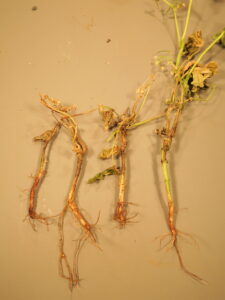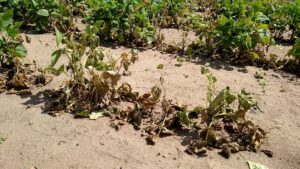Root rot of snap bean can be a devastating disease in Indiana. Often, the first symptom observed is the collapse and wilt of the plant (Figure 1). The roots of such plants may be discolored and rotten (Figure 2). Lower areas of the field and fields which are not well drained are more likely to be affected than well drained areas. Beans planted relatively early in the season are more likely to be affected than later planted beans or second crop beans.

Figure 2: Root rot of snap bean can be characterized by necrotic lesions on the lower stem and roots.
There are many fungal pathogens that may be responsible for root rot of snap bean. The fungal pathogens include Fusarium spp., Rhizoctonia sp., Macrophomina, Pythium spp. (Pythium is actually a fungus-like organism—not a true fungus) and Thielaviopsis sp. These fungi may act alone or together to cause root rot. All of these fungi survive well in the soil and in crop residue. When root systems are compromised, for example in cool, poorly drained, compacted soils, these fungi may cause the symptoms shown above.
Management of root rot of snap bean is complex and difficult. Below are some suggestions that may help to alleviate symptoms.
Crop rotation-avoid planting green beans or other legumes in short rotations. Other crops to avoid are ones that may be susceptible to the pathogens named above: beets, cabbage, melons, peas, potatoes, soybeans.
Plow under snap beans after the season and plow under cover crops before planting beans. Allow enough time for decomposition of crop residue before planting beans. Prepare soil 5 days or more in advance of planting beans to avoid problems with Rhizoctonia sp.
Subsoil to help to promote root growth. Growing on raised beds or ridges increases soil aeration and soil temperature.
Choose fields that are well drained, as much as possible. Tiling may help to increase drainage and thus plant growth.
Later plantings tend to have fewer root rot problems in most years. As much as possible, adjust planting depth to shallow for fields where root rot has been a problem.
Root rot severity tends to increase with increasing plant densities. Reduce plant densities: row spacings that are close tend to produce dense plant canopies which increases root rot severity.
Avoid cultivations of beans that are in fields with a history of root rot. Cultivations that are too close to the plant may interfere with root growth.
Although few cultivars are resistant to root rots in fresh beans, chose varieties that are known to have fewer problems. Ask your seed rep for help.
Fungicides-Seed treated with fungicide may help to reduce rot of the seed and young seedling. Contact products such as Thiram® and Captan® coat the seed and will help protect it from fungi that may rot the seed. Other products are systemic and work by moving into the germinating seedling. Such products include:
- the active ingredient azoxystrobin (e.g., Dynasty®) may help to manage Rhizoctonia root rot.
- thiabendazole (e.g., Mertect®) may help to protect the young seedling from infections including Fusarium
- mefenoxam (e.g., Apron Maxx®) may help to protect the young seedling from Pythium infections.
- fludioxanil (e.g., Maxim®) may help to prevent diseases caused by fungi in the Diaporthe–Phomopsis complex
- Some seed suppliers may offer seed with mixes of different fungicides and insecticides. Ask about the fungicides and insecticides and what purpose they serve. Some portions of the seed treatments may be unnecessary.
Soil applied fungicides may help to lessen the severity of root rot. Such treatments are more likely to be cost effective in fields where there has been a history of root rot.
- Products with the active ingredient mefenoxam (e.g., Ridomil Gold SL®), may help to manage infections caused by Pythium
- Products with the active ingredient azoxystrobin (e.g., Quadris®) may help to manage diseases caused by Rhizoctonia
